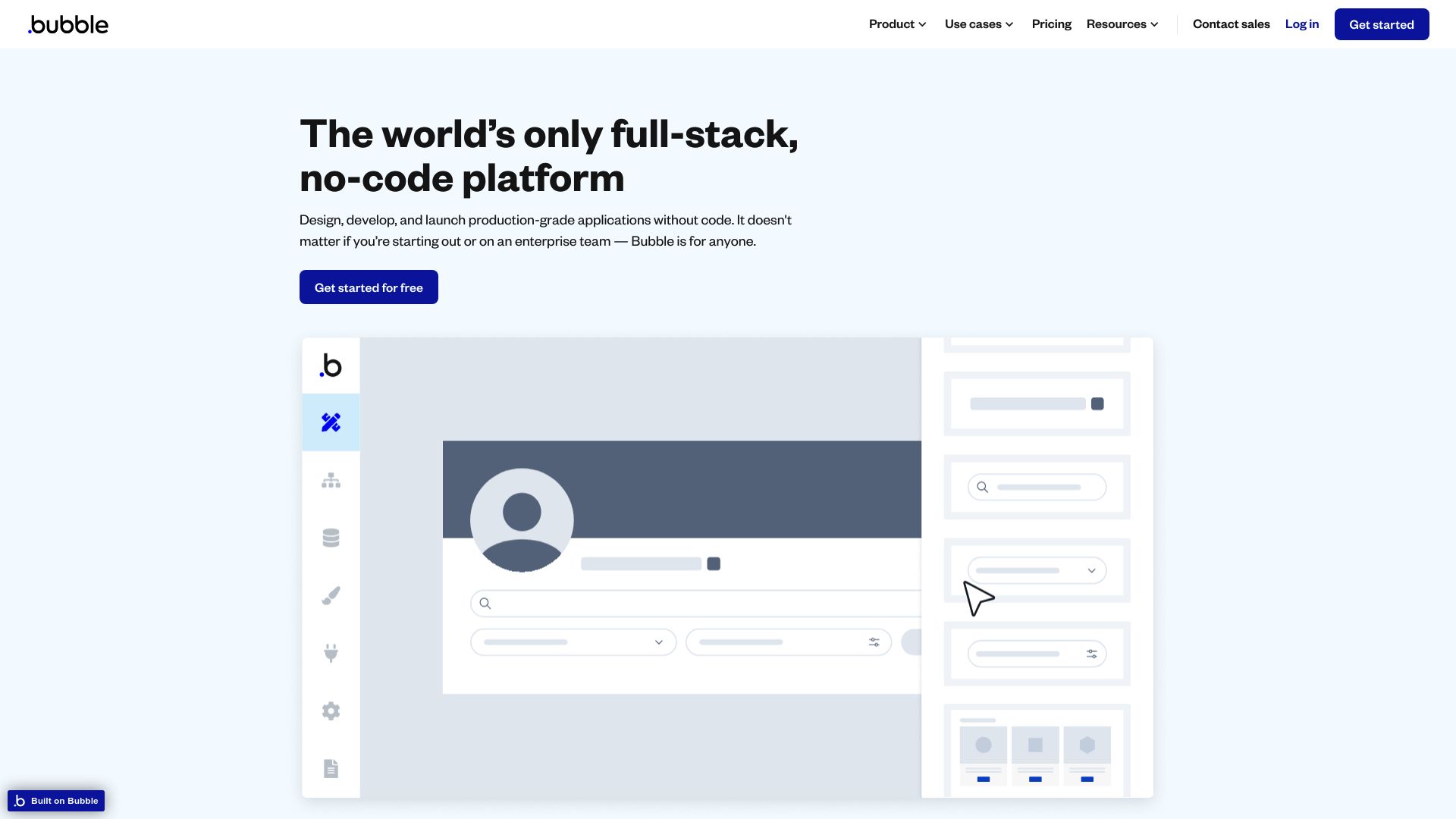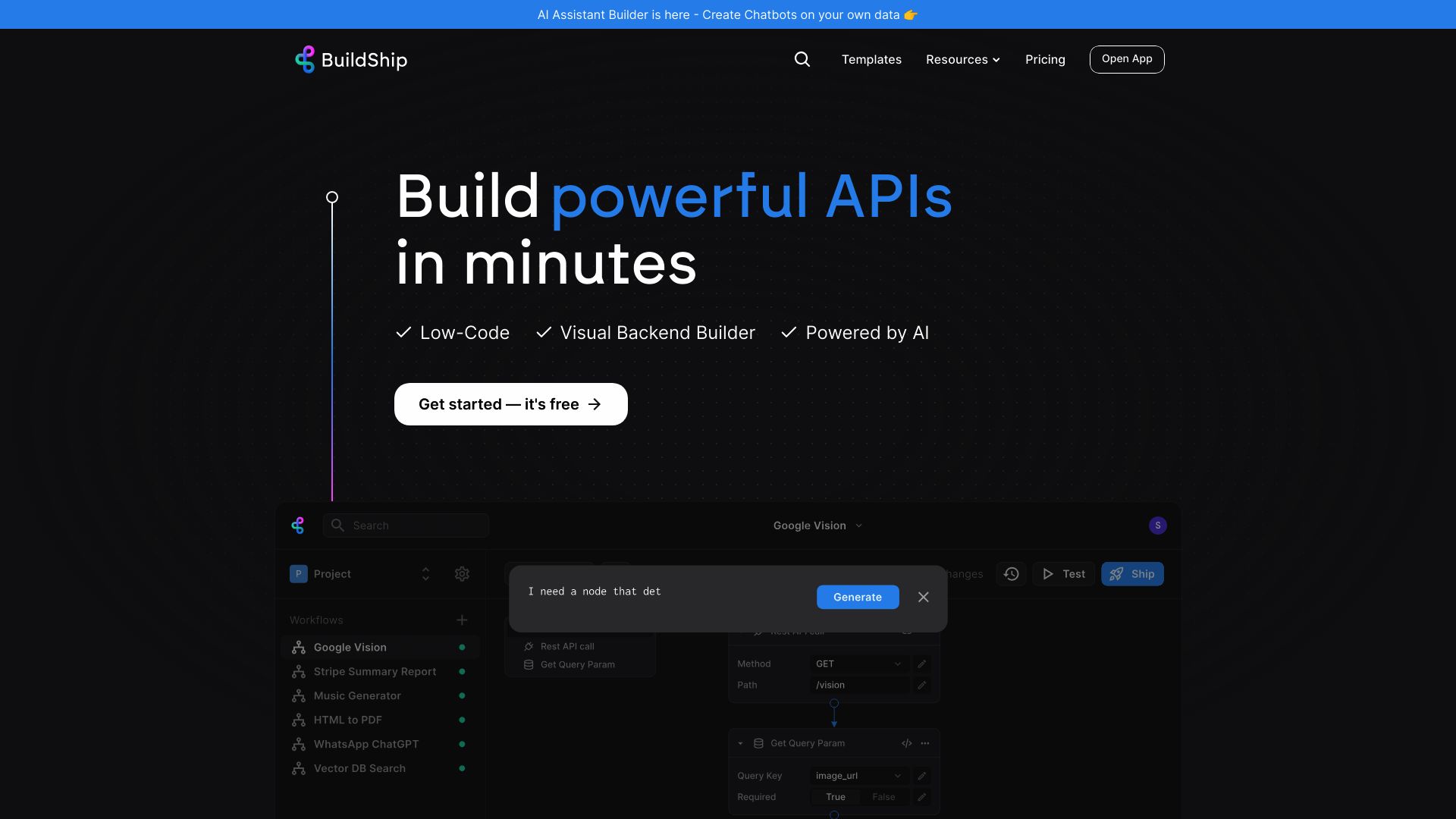Bubble vs. BuildShip: AI-Powered Development Platforms Compared
AI-powered software development platforms revolutionize how businesses create applications and automate workflows. This comparison explores Bubble vs. BuildShip, and SmythOS, three leading solutions in the no-code and AI-enhanced development space. We examine their core features, strengths, and limitations to help you choose the right tool for your project.
Whether you’re a developer seeking rapid prototyping capabilities, a business leader looking to streamline operations, or an entrepreneur with a groundbreaking app idea, this analysis provides valuable insights into each platform’s unique offerings and how they stack up against emerging AI-driven alternatives.
Bubble Overview
Bubble revolutionizes web application development with its no-code platform. Users create sophisticated web apps through an intuitive drag-and-drop interface, eliminating the need for traditional coding. This visual approach democratizes app development, enabling individuals and businesses to bring their ideas to life without extensive technical knowledge.
Bubble revolutionizes web application development with its no-code platform. Users create sophisticated web apps through an intuitive drag-and-drop interface, eliminating the need for traditional coding.
The platform’s strength lies in its flexibility and integration capabilities. Bubble seamlessly connects with AI services like OpenAI’s GPT models through plugins and API connectors. This integration empowers users to incorporate advanced AI functionalities such as chatbots, content generation, and image processing into their applications.


Bubble offers a robust marketplace of pre-built templates and plugins, accelerating development and expanding functionality. The platform supports real-time collaboration and version control, making it suitable for both individual developers and teams. Built on Amazon Web Services, Bubble ensures scalability and security, with features like GDPR compliance and SOC 2 Type II certification.
Bubble offers a robust marketplace of pre-built templates and plugins, accelerating development and expanding functionality.
While Bubble excels in web application development, it lacks some specialized AI agent capabilities. The platform doesn’t offer hosted AI agents or autonomous agent features. However, it compensates with strong integration options, allowing users to leverage external AI services to enhance their applications. Bubble’s visual builder and no-code approach make it accessible to a wide range of users, from non-technical professionals to experienced developers looking to prototype quickly.
BuildShip Overview
BuildShip empowers users to create, test, and deploy backend workflows and APIs without extensive coding knowledge. The platform’s visual no-code interface allows developers and businesses to rapidly build complex automations and integrations.
At its core, BuildShip offers a drag-and-drop workflow builder with pre-built nodes for common tasks. Users can connect various data sources, APIs, and AI models to construct powerful backend processes. For added flexibility, BuildShip supports custom logic written in JavaScript or TypeScript.
BuildShip stands out with its AI-powered features. The platform can generate custom nodes based on natural language prompts, accelerating development. AI autofill capabilities further streamline workflow creation by suggesting inputs and configurations. These AI-driven tools make BuildShip accessible to users with varying technical backgrounds.
BuildShip empowers users to create, test, and deploy backend workflows and APIs without extensive coding knowledge… allows developers and businesses to rapidly build complex automations and integrations.


Once workflows are built, BuildShip provides robust testing capabilities. Users can validate individual nodes or entire processes before deployment. When ready, workflows can be exposed as production-grade APIs for integration into applications. The platform also supports scheduled execution of workflows for automated tasks.
BuildShip prioritizes security with features like OAuth integration and secure storage for API keys and secrets. This ensures sensitive data remains protected throughout the development and deployment process. The platform’s template library accelerates common use cases, while its scalable infrastructure supports growing application demands.
BuildShip prioritizes security with features like OAuth integration and secure storage for API keys and secrets. This ensures sensitive data remains protected throughout the development and deployment process.
While BuildShip excels at backend automation, it lacks some advanced AI agent capabilities found in dedicated agent builders. The platform doesn’t offer features like autonomous agents, multi-agent collaboration, or advanced natural language processing. However, for users focused on workflow automation and API creation, BuildShip provides a powerful and accessible solution.
Feature Comparison
Bubble and BuildShip offer distinct approaches to application development, each with its own strengths and limitations. Bubble excels in visual web application building, providing a comprehensive no-code platform for creating complex web apps. Its drag-and-drop interface and extensive plugin marketplace empower users to build sophisticated applications without writing code. However, Bubble lacks specific AI agent capabilities and autonomous features.
BuildShip, on the other hand, focuses on backend workflow automation and API creation. It provides a visual interface for constructing complex backend processes and integrations. BuildShip’s AI-powered features, such as node generation from natural language prompts and AI autofill, streamline development for users with varying technical backgrounds. However, BuildShip doesn’t offer advanced AI agent functionalities like autonomous agents or multi-agent collaboration.
In terms of core components, both platforms have limitations. While Bubble provides a robust visual builder and supports various integrations, it lacks built-in AI agent hosting and autonomous capabilities. BuildShip offers AI-enhanced workflow creation but doesn’t provide the same level of frontend development tools as Bubble. Regarding security, both platforms prioritize data protection, with Bubble using encryption for data at rest and in transit, and BuildShip offering secure storage for API keys and secrets. However, neither platform explicitly mentions advanced AI-specific security measures like constrained alignment.
Feature Comparison Table
| Bubble | BuildShip | SmythOS | |
|---|---|---|---|
| CORE FEATURES | |||
| Memory & Context | ❌ | ❌ | ✅ |
| Autonomous Agents | ❌ | ❌ | ✅ |
| Explainability & Transparency | ❌ | ❌ | ✅ |
| Multimodal | ❌ | ❌ | ✅ |
| Problem-Solving Capabilities | ✅ | ❌ | ✅ |
| Multi-Agent Collaboration | ❌ | ❌ | ✅ |
| Human-AI Interaction | ✅ | ❌ | ✅ |
| Audit Logs for Analytics | ✅ | ❌ | ✅ |
| Work as Team | ✅ | ❌ | ✅ |
| Bulk Work | ❌ | ✅ | ✅ |
| Agent Work Scheduler | ❌ | ✅ | ✅ |
| SECURITY | |||
| Constrained Alignment | ❌ | ❌ | ✅ |
| IP Control | ❌ | ✅ | ✅ |
| COMPONENTS | |||
| Foundation AIs | ✅ | ❌ | ✅ |
| Huggingface AIs | ❌ | ❌ | ✅ |
| Zapier APIs | ✅ | ❌ | ✅ |
| Classifiers | ❌ | ❌ | ✅ |
| Data Lakes | ✅ | ❌ | ✅ |
| DEPLOYMENT OPTIONS (EMBODIMENTS) | |||
| Deploy as API | ❌ | ✅ | ✅ |
| Staging Domains | ✅ | ❌ | ✅ |
| Production Domains | ✅ | ❌ | ✅ |
| Deploy as Site Chat | ✅ | ❌ | ✅ |
| Deploy as Scheduled Agent | ❌ | ✅ | ✅ |
| Deploy as GPT | ✅ | ❌ | ✅ |
| DATA LAKE SUPPORT | |||
| Hosted Vector Database | ❌ | ❌ | ✅ |
| Sitemap Crawler | ❌ | ❌ | ✅ |
| YouTube Transcript Crawler | ❌ | ❌ | ✅ |
| URL Crawler | ❌ | ❌ | ✅ |
| PDF Support | ✅ | ❌ | ✅ |
| Word File Support | ✅ | ❌ | ✅ |
| TXT File Support | ✅ | ❌ | ✅ |
Best Alternative to Bubble and BuildShip
SmythOS offers a superior alternative to Bubble and BuildShip for AI agent development and automation. Our platform combines powerful AI capabilities with an intuitive interface, enabling users to create sophisticated AI agents without extensive coding knowledge. We provide a comprehensive solution that addresses limitations found in Bubble and BuildShip.
Unlike Bubble’s focus on general web app creation or BuildShip’s backend workflow emphasis, SmythOS specializes in AI agent development. We offer autonomous agents with memory and context awareness — capabilities missing from both competitors. Our multi-agent collaboration feature facilitates complex problem-solving beyond what Bubble or BuildShip can achieve.
SmythOS specializes in AI agent development. We offer autonomous agents with memory and context awareness — capabilities missing from both competitors.
We excel in ease of use while maintaining advanced functionality. Our visual drag-and-drop interface rivals Bubble’s simplicity but extends to AI-specific components. Unlike BuildShip’s limited frontend options, we provide end-to-end agent creation and deployment. SmythOS supports diverse embodiments including APIs, chatbots, and scheduled agents — surpassing the deployment flexibility of either competitor.
Our platform shines in its extensive integration ecosystem and scalability. We support a wide array of AI models, APIs, and data sources — offering greater versatility than Bubble or BuildShip. For enterprises requiring robust solutions, we provide unmatched scalability and security features like constrained alignment. Whether you’re a beginner exploring AI or an enterprise seeking powerful automation, SmythOS delivers the ideal balance of accessibility and capability that Bubble and BuildShip cannot match.
Conclusion
Bubble and BuildShip offer powerful solutions for application development and workflow automation, each with unique strengths. Bubble excels in visual web app creation, while BuildShip focuses on backend processes and API generation. Both platforms provide accessible no-code interfaces, but lack advanced AI agent capabilities.
SmythOS emerges as the superior choice, combining the best of both worlds with additional AI-driven features. Our platform offers unparalleled flexibility in agent creation and deployment, supporting multimodal interactions, autonomous operations, and seamless integrations with over 300,000 APIs and services.
Unlike Bubble and BuildShip, SmythOS provides hosted AI agents, multi-agent collaboration, and advanced natural language processing capabilities. We prioritize security with features like constrained alignment and data encryption, ensuring your AI solutions remain safe and compliant.
For businesses and developers seeking to harness the full potential of AI, SmythOS delivers a comprehensive ecosystem. Explore our diverse range of AI-powered agent templates to jumpstart your projects, or dive into our documentation to understand the full scope of our platform’s capabilities. Create a free SmythOS account today and experience the future of AI-powered automation with our risk-free trial.
Last updated:
Disclaimer: The information presented in this article is for general informational purposes only and is provided as is. While we strive to keep the content up-to-date and accurate, we make no representations or warranties of any kind, express or implied, about the completeness, accuracy, reliability, suitability, or availability of the information contained in this article.
Any reliance you place on such information is strictly at your own risk. We reserve the right to make additions, deletions, or modifications to the contents of this article at any time without prior notice.
In no event will we be liable for any loss or damage including without limitation, indirect or consequential loss or damage, or any loss or damage whatsoever arising from loss of data, profits, or any other loss not specified herein arising out of, or in connection with, the use of this article.
Despite our best efforts, this article may contain oversights, errors, or omissions. If you notice any inaccuracies or have concerns about the content, please report them through our content feedback form. Your input helps us maintain the quality and reliability of our information.
